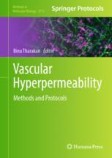Search
Search Results
-
JNK inhibition enhances cell–cell adhesion impaired by desmoglein 3 gene disruption in keratinocytes
c-Jun NH 2 -terminal protein kinase (JNK) and p38 are stress-activated mitogen-activated protein kinases (MAPK) that are phosphorylated by various...

-
Exonic mutations in cell–cell adhesion may contribute to CADASIL-related CSVD pathology
Cerebral autosomal dominant arteriopathy with subcortical infarcts and leukoencephalopathy (CADASIL) is a condition caused by mutations in NOTCH3 and...

-
Regulation of Presynaptic Release Machinery by Cell Adhesion Molecules
The synapse is a highly specialized asymmetric structure that transmits and stores information in the brain. The size of pre- and postsynaptic...
-
Targeting of H19/cell adhesion molecules circuitry by GSK-J4 epidrug inhibits metastatic progression in prostate cancer
BackgroundAbout 30% of Prostate cancer (PCa) patients progress to metastatic PCa that remains largely incurable. This evidence underlines the need...

-
Oligomeric Amyloid-β and Tau Alter Cell Adhesion Properties and Induce Inflammatory Responses in Cerebral Endothelial Cells Through the RhoA/ROCK Pathway
Dysfunction of cerebral endothelial cells (CECs) has been implicated in the pathology of Alzheimer’s disease (AD). Despite evidence showing cytotoxic...

-
Tumor removal limits prostate cancer cell dissemination in bone and osteoblasts induce cancer cell dormancy through focal adhesion kinase
BackgroundDisseminated tumor cells (DTCs) can enter a dormant state and cause no symptoms in cancer patients. On the other hand, the dormant DTCs can...

-
Quantifying Adhesion of Inflammatory Cells to the Endothelium In Vitro
We present a simple and quantitative assay system that accurately models human endothelium by use of primary human umbilical vein endothelial cells...
-
The Impact of MicroRNAs in Cell Adhesion and Tumour Angiogenesis
MicroRNAs (miRNAs) are a class of non-coding RNAs of roughly 22 nt length that plays a salient and myriad role in gene expression and regulation....
-
Selecting Plasmodium falciparum Infected Erythrocytes for Adhesion to Cell Lines
Plasmodium falciparum expresses variant surface antigens on the surface of mature infected erythrocytes (IEs) for binding to various receptors on...
-
Hypoxia modulates human mast cell adhesion to hyaluronic acid
Hypoxia is an inherent factor in the inflammatory process and is important in the regulation of some immune cell functions, including the expression...

-
Fibrin Hydrogel Layer-Anchored Pericardial Matrix Prevents Epicardial Adhesion in the Severe Heart Adhesion-Induced Miniature Pig Model
Postoperative adhesion is a very common and serious complication that occurs frequently in cardiac surgery. The purpose of this study was to evaluate...

-
The interaction between adhesion protein 33 (TvAP33) and BNIP3 mediates the adhesion and pathogenicity of Trichomonas vaginalis to host cells
BackgroundTrichomonas vaginalis is a widespread and important sexually transmitted pathogen. Adherence to the surface of the host cell is the...

-
SPATA33 affects the formation of cell adhesion complex by interacting with CTNNA3 in TM4 cells
Communication between Sertoli cell is essential during spermatogenesis and testicular development in mice, and the dynamic balance of this...

-
Vascular Cell Adhesion Molecule-1 (VCAM-1) contributes to macular fibrosis in neovascular age-related macular degeneration through modulating macrophage functions
BackgroundNeovascular age-related macular degeneration (nAMD) is a major cause of blindness in the elderly. The disease is due to the growth of...

-
Ubiquitous Neural Cell Adhesion Molecule (NCAM): Potential Mechanism and Valorisation in Cancer Pathophysiology, Drug Targeting and Molecular Transductions
Neural cell adhesion molecule, an integrated molecule of immunoglobulin protein superfamily involved in cell-cell adhesion, undergoes various...

-
Changes in Adhesion and the Expression of Adhesion Molecules in PBMCs after Aneurysmal Subarachnoid Hemorrhage: Relation to Cerebral Vasospasm
Aneurysmal subarachnoid hemorrhage (aSAH) is a neurovascular disease produced by extravasation of blood to the subarachnoid space after rupture of...

-
Interfaces to Control Cell-Biomaterial Adhesive Interactions
Cell adhesion to adsorbed proteins and adhesive sequences engineered on surfaces is crucial to cellular and host responses to implanted devices,...
-
Epithelial cell adhesion molecule (EpCAM) regulates HGFR signaling to promote colon cancer progression and metastasis
BackgroundEpithelial cell adhesion molecule (EpCAM) is known to highly expression and promotes cancer progression in many cancer types, including...

-
The cell adhesion molecule TMIGD1 binds to moesin and regulates tubulin acetylation and cell migration
BackgroundThe cell adhesion molecule transmembrane and immunoglobulin (Ig) domain containing1 (TMIGD1) is a novel tumor suppressor that plays...

-
A systematic review and meta-analysis of circulating adhesion molecules in rheumatoid arthritis
BackgroundThe availability of robust biomarkers of endothelial activation might enhance the identification of subclinical atherosclerosis in...

